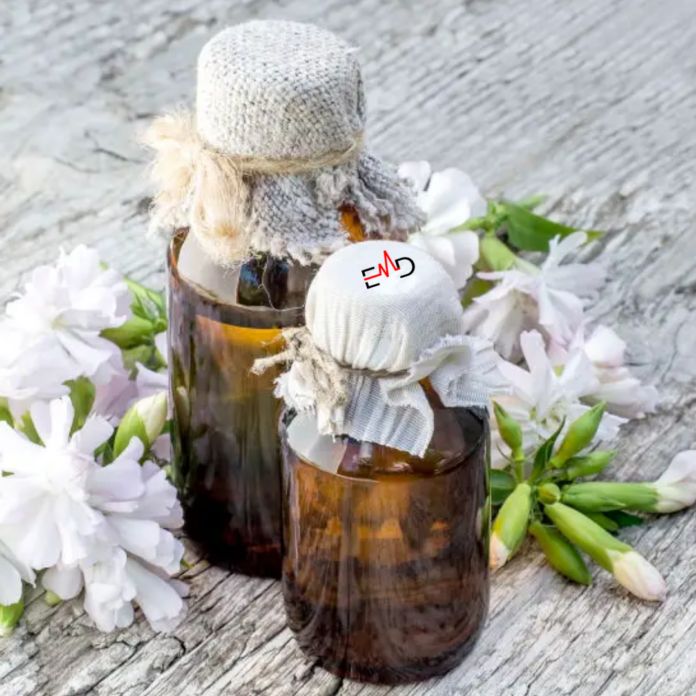
Exercise Daily – Soapwort, also known as Saponaria officinalis or bouncing bet, is a gentle yet effective cleanser celebrated for its natural soap-like cleaning action. This pretty plant, often mistaken for soapnuts, contains saponins, which create a natural lather when mixed with water, making it an excellent alternative to chemical-based cleaners. Soapwort is a versatile herb, with its whole plant, especially the dried root, traditionally used in creating gentle soap for skin and hair care. It is a natural shampoo, face wash, and even a soap for sensitive medical conditions. Additionally, tea made from soapwort can be used as a conditioning rinse, leaving hair squeaky clean and free from harsh residues. For those trying natural cleaning agents, soapwort soap is an eco-friendly choice.
Beyond personal care, the soapwort plant is also valuable in household cleaning. Its natural saponins are ideal for making soap, dishwashing solutions, and general cleaning agents that are safe for the environment and your home. Although it makes neither medical claims nor intends to diagnose or treat any conditions, soapwort is an ancient remedy worth exploring for those interested in herbal alternatives. For DIY enthusiasts, using soapwort or soapnuts in homemade cleaning recipes can provide gentle yet powerful results without the use of harsh chemicals or preservatives.

The Growing Popularity of Natural Cleaning Solutions
With the growing awareness of the harmful effects of chemical-laden cleaning products, there has been a significant shift towards natural alternatives. Soapwort is a sustainable, eco-friendly solution that can help reduce chemical exposure in your home while being gentle on your skin and the environment. Whether you’re looking to cut back on store-bought detergents, find gentler solutions for personal care, or minimize your environmental footprint, soapwort is the perfect ally in your green cleaning journey.
Washing your athletic clothing with soapwort not only helps keep it clean and fresh but also reduces the risk of skin irritation and rashes. Because soapwort is gentle and naturally hypoallergenic, it is a perfect choice for athletes who experience frequent skin sensitivity or those who want a more natural, eco-friendly laundry solution. Incorporating soapwort into your laundry routine can help soothe your skin, improve your athletic comfort, and extend the life of your sportswear.

The History of Soapwort
Ancient Origins of Soapwort
Soapwort’s history dates back to ancient times when it was widely used across Europe and Asia for washing wool, textiles, and even personal hygiene. In medieval Europe, soapwort was a common sight in monastery gardens, where it was cultivated for its utility in cleaning delicate fabrics like wool and silk. Its nickname, “Bouncing Bet,” is a playful reference to the way soapwort produces a foamy, soapy lather when mixed with water and agitated.
A Staple in Textile Care
Historically, soapwort played an essential role in textile production. Before the advent of modern detergents, this plant was used to clean and treat fabrics, especially wool, which could easily be damaged by harsher cleaning agents. Soapwort’s mild yet effective saponin content allowed it to cleanse without stripping or weakening the fibers, making it a trusted solution for artisans and homemakers.
Soapwort for Washing Athletic Clothing
Athletes often struggle with skin rashes and irritation caused by excess sweat, tight-fitting clothing, and the harsh chemicals in traditional detergents. When synthetic detergents don’t fully rinse out of fabrics, they can leave behind residue that mixes with sweat, clog pores, and lead to conditions like heat rash, dermatitis, and even fungal infections.
With its gentle yet effective saponin content, Soapwort offers an ideal alternative for washing athletic clothing. Its natural foaming action removes dirt, oils, and sweat from fabrics without leaving behind irritating chemical residues. Unlike many commercial detergents, soapwort doesn’t contain sulfates, artificial fragrances, or other additives that can exacerbate skin irritation—particularly after vigorous exercise when the skin is more sensitive.
Soapwort’s Natural Cleansing Power
The Role of Saponin in Cleaning
The secret behind soapwort’s cleaning ability is saponin, a plant-based compound that forms a gentle lather when mixed with water. Saponin is particularly effective in breaking down oils, dirt, and grease, which makes soapwort an ideal alternative to traditional detergents and soaps. Unlike commercial cleansers that often contain harsh chemicals, soapwort cleanses without stripping the natural oils from your skin, hair, or household surfaces.
Environmentally Friendly Cleaning
One of the biggest advantages of using soapwort is its low environmental impact. Saponin, the active ingredient, is biodegradable and doesn’t contribute to water pollution, unlike many synthetic detergents. By switching to soapwort for your cleaning needs, you’re not only protecting your skin and home but also contributing to a healthier planet.

Growing Soapwort in Your Garden
Soapwort: A Hardy and Easy-to-Grow Plant
Soapwort is a versatile and hardy perennial that is incredibly easy to grow in most gardens. With its attractive pink or white flowers that bloom in late summer, soapwort can be both an ornamental and a functional addition to your garden. It thrives in well-drained soil and full sun but can tolerate partial shade, making it suitable for various climates. Once established, soapwort spreads quickly, so you’ll have a consistent supply of this valuable plant for years to come.
Propagation and Care
Soapwort can be propagated from seeds or cuttings, making it a flexible addition to your garden. To get started, plant the seeds in early spring or take cuttings from an established plant during the growing season. Water moderately, ensuring that the soil remains well-drained. Soapwort is relatively low-maintenance, though it can spread vigorously, so occasional trimming or thinning may be necessary to keep it in check.
Harvesting Soapwort
Harvesting soapwort is simple. Both the leaves and roots contain high levels of saponin so that you can use either depending on your needs. The best time to harvest the leaves and flowers is in late summer, just as the plant reaches full bloom. For the roots, harvest in the fall when the plant begins to die back. You can use the plant fresh or dry it for future use, ensuring you have soapwort on hand all year round.
Soapwort for Personal Care
A Natural Hair Cleanser – Soapwort Shampoo
Soapwort is an excellent alternative to conventional shampoos, especially for those with sensitive scalps or who are looking to avoid the synthetic chemicals found in commercial hair care products. Soapwort shampoo cleanses the hair without stripping it of its natural oils, leaving your hair soft, clean, and refreshed.
How to Make Soapwort Shampoo
To make soapwort shampoo, follow these simple steps:
- Take a handful of fresh or dried soapwort leaves and roots.
- Combine with 2 cups of water in a pot and bring to a boil.
- Simmer for 15-20 minutes until the mixture creates a mild lather.
- Strain the liquid and allow it to cool.
- Optionally, add a few drops of rosemary or lavender essential oil for added fragrance and hair-nourishing properties.
Use this shampoo as you would any other, gently massaging it into your scalp and rinsing thoroughly. Over time, you may notice your hair feels healthier and less weighed down by synthetic ingredients.
Soapwort as a Skin Cleanser
Soapwort’s gentle cleansing properties make it ideal for sensitive or acne-prone skin. It can be used as a mild facial cleanser that removes dirt and oil without causing irritation or dryness. The anti-inflammatory properties of saponin also help soothe irritated skin, making it a great option for people with conditions like eczema or psoriasis.
Soapwort Face Cleanser Recipe
- Boil a small handful of soapwort leaves or roots in 1 cup of water for 15 minutes.
- Strain the liquid and let it cool.
- Use a cotton pad to apply the soapwort infusion to your face.
- Rinse with water and pat dry.
This cleanser is gentle enough for daily use and can leave your skin feeling soft and refreshed without the need for harsh chemicals.

Soapwort for Household Cleaning
Soapwort for Dishwashing
Soapwort’s mild saponin content is perfect for washing dishes. It cuts through grease effectively while being gentle on your hands, making it an ideal eco-friendly alternative to conventional dish soap.
How to Make Soapwort Dish Soap
- Prepare a basic soapwort infusion by boiling 1 cup of fresh or dried soapwort leaves in 2 cups of water.
- Simmer for 15-20 minutes and then strain the liquid.
- Add a few drops of lemon or rosemary essential oil for a pleasant scent and extra grease-cutting power.
- Use this liquid directly to wash dishes or pour it into a reusable dish soap dispenser.
Soapwort as a Laundry Detergent
Soapwort can also be used as a natural laundry detergent. Its mild nature makes it ideal for delicate fabrics like wool, silk, or baby clothes.
How to Use Soapwort for Laundry
- Prepare a soapwort infusion as described above.
- Add the strained liquid to your washing machine in place of regular detergent.
- For extra stain-fighting power, you can add a scoop of baking soda or a splash of white vinegar to your wash cycle.
Soapwort for All-Purpose Cleaning
Soapwort can also be used for general household cleaning. Its natural saponin content makes it perfect for wiping down surfaces, cleaning floors, and even refreshing upholstery.
How to Make Soapwort All-Purpose Cleaner
- Prepare a basic soapwort infusion.
- Pour the strained liquid into a spray bottle.
- Use it to clean countertops, floors, and other surfaces.
- Mix in a few drops of tea tree or eucalyptus essential oil for added disinfecting power.
This cleaner is non-toxic, biodegradable, and safe for use around pets and children.
Medicinal Uses of Soapwort
External Medicinal Uses of Soapwort
Soapwort has long been used to treat skin conditions such as eczema, psoriasis, and rashes. Its anti-inflammatory properties make it ideal for soothing irritated or inflamed skin.
How to Use Soapwort for Skin Conditions
- Prepare a soapwort infusion.
- Soak a clean cloth in the infusion and apply it to the affected area.
- Repeat this process daily until symptoms improve.
Internal Medicinal Uses of Soapwort
Internally, traditional medicine has used soapwort to treat respiratory conditions like bronchitis and coughs. However, soapwort can be toxic when ingested in large amounts, so it is crucial to consult a healthcare provider before using it internally.
Soapwort Recipes for Green Cleaning
Basic Soapwort Infusion Recipe
A basic soapwort infusion can be the foundation for various cleaning solutions.
Ingredients:
- 1 cup of chopped fresh or dried soapwort leaves or roots
- 2 cups of water
Instructions:
- Combine soapwort and water in a saucepan.
- Bring to a boil and simmer for 15 minutes.
- Strain and store the liquid in a glass jar or spray bottle.
This infusion can be used as a base for everything from shampoo to all-purpose cleaners.
Soapwort and Rosemary Dish Soap Recipe
Combine soapwort with rosemary essential oil to boost the power of natural dishwashing with soapwort.
Ingredients:
- Soapwort infusion
- A few drops of rosemary essential oil
Instructions:
- Add rosemary essential oil to your soapwort infusion.
- Use this mixture as a fragrant and effective dishwashing soap.
Soapwort Laundry Detergent Recipe
This soapwort detergent is perfect for eco-conscious laundry routines.
Ingredients:
- Soapwort infusion
- 1/2 cup of baking soda (optional)
- 1/4 cup of white vinegar (optional)
Instructions:
- Add soapwort infusion to your washing machine.
- Include baking soda for extra whitening and vinegar for softening if desired.

Conclusion
Soapwort is a versatile and sustainable option for those seeking natural alternatives to conventional cleaning products. Whether used for personal care, household cleaning, or even medicinal purposes, soapwort offers gentle yet effective results without the use of harsh chemicals. By incorporating soapwort into your daily routine, you can take a significant step towards a greener, healthier lifestyle for yourself and the environment.
FAQs – Green Cleaning with Soapwort: Recipes and Uses
Q: What is soapwort?
A: Soapwort (Saponaria officinalis) is a plant known for its natural soap-like properties, thanks to its high saponin content.
Q: How do I make soapwort shampoo?
A: Boil soapwort leaves and roots in water, strain, and use the liquid as a gentle shampoo. Add essential oils for extra benefits.
Q: Can soapwort be used for laundry?
A: Yes, soapwort can be used as a natural laundry detergent. Just use a soapwort infusion in place of regular detergent.
Q: Is soapwort safe for sensitive skin?
A: Yes, soapwort is gentle and suitable for sensitive skin, making it a good alternative to commercial cleansers.
Q: Can I grow soapwort at home?
A: Yes, soapwort is easy to grow and thrives in well-drained soil with plenty of sunlight.




